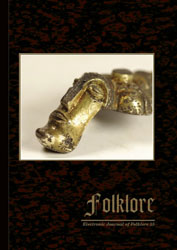Hulje: Calendrical Rites along a Small Stream
Hulje: Calendrical Rites along a Small Stream
Author(s): Maria PeterssonSubject(s): Customs / Folklore
Published by: Eesti Kirjandusmuuseum
Keywords: Iron Age; Old Norse religion; ritual meals; sacrifices; well; wooden objects
Summary/Abstract: In 2010, a ceremonial site dated to the Late Bronze Age and the Iron Age was excavated. The name of the site is Hulje and it is situated a couple of kilometres to the north of the town of Mjölby in Östergötland (East Gothland) County, Sweden. A small rocky hillock with several hundred cup-marks dominates the area of the ceremonial site. Approximately 50 metres from the site, a small stream once flowed. From the Late Bronze Age and Early Pre-Roman Iron Age to Early Medieval Times (c. 700 BC–AD 1100) the area around the stream was a site of activities charged with religious meaning. There were cooking pits of an exceptional size, in which most probably ceremonial meals were prepared. Fire-cracked stones and other waste materials from ceremonial meals were specially treated and deposited in the bed of the stream or along its banks. A few boulders might have constituted the foundation of a platform projecting out into the stream. Dug into the side of the stream there was a well, in which religious ceremonies were held, mainly during the Early Roman Iron Age (AD 1–200). Extremely well-preserved wooden artefacts have been found in this context. In this article, my aim is to give quite a detailed overview of the site and the excavations. Some further aspects to be discussed concern the type of the site, the origin of the people who performed the ceremonies that we can see traces of, the time when the ceremonies were performed, and their purpose. Finally, Hulje is compared to other similar sites in Sweden.
Journal: Folklore: Electronic Journal of Folklore
- Issue Year: 2013
- Issue No: 55
- Page Range: 11-48
- Page Count: 38
- Language: English

